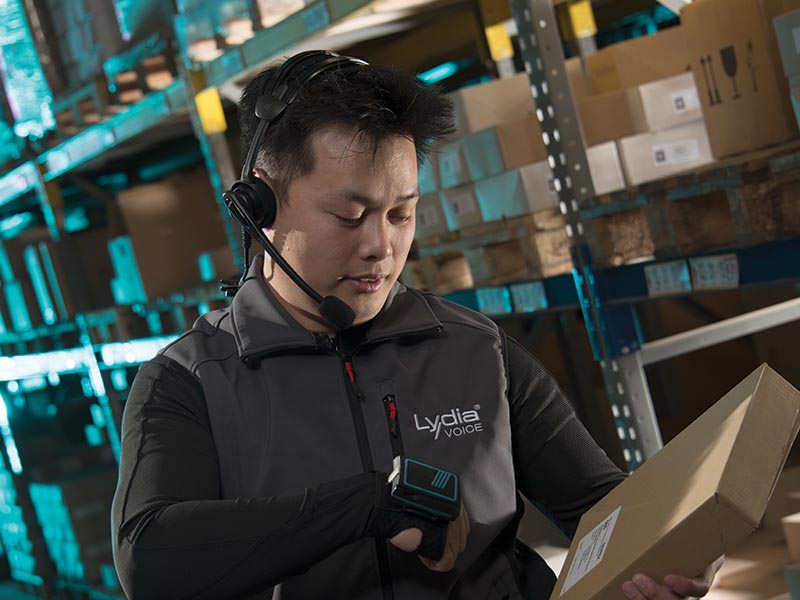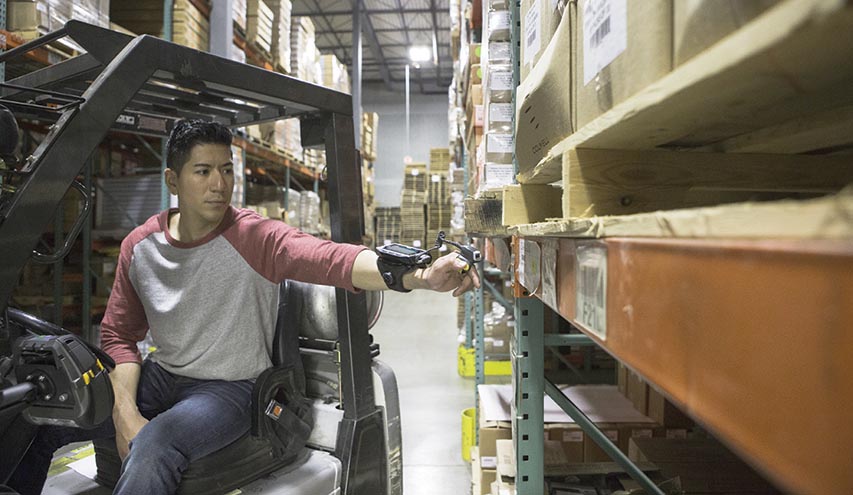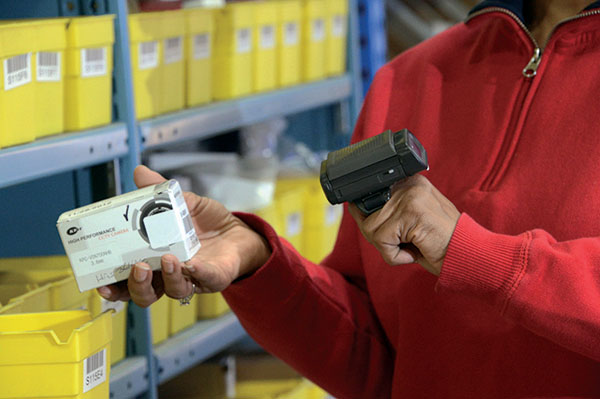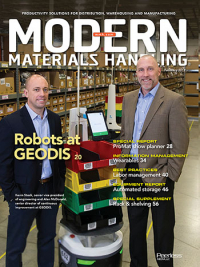Modern Mobility: Wear it while you work
In the hunt for the next level of productivity, mobile devices can help pave the way—if they can get out of the way.
Each year, the processing power, size and capability of mobile devices improve. The same holds for consumer or industrial devices, although the appetite for cutting-edge technology is very different in those two sectors. Warehousing and distribution are proudly risk-averse, and even those who have sought to modernize are often limited by unwieldy legacy software and entrenched processes that have changed little over the decades.
Call it a perfect storm, tipping point or paradigm shift, but a confluence of factors is poised to rapidly and radically transform the use of mobile devices in warehouses and DCs.
The impending support sunset for Windows mobile operating systems (OS) is driving a mass migration to Android OS, a platform that promises lifelong support for enterprise devices, easy integration of smart devices like tablets and wearables, and improved security.
Cloud-based or managed services are growing in popularity, decreasing the IT burden while increasing long-term operational agility. Analytics, artificial intelligence, neural networks and machine learning are improving the ability of mobile devices and voice-directed solutions to capture and process data to optimize operations.
This is all happening against a backdrop of vastly greater savviness among users and solution providers.
“There’s a lot of awareness now in terms of the ‘fit for use’ of a device,” says Krishna Venkatasamy, chief technology officer for Lucas Systems. “Ten years ago customers would buy a scan gun whether they needed it or not. But now if they’re using voice for data entry, why carry the gun, too? Buyers are smarter and are deciding on devices based on their fitness for the application.”
The industry is moving toward shrinking form factors for devices, Venkatasamy says, especially in voice-directed applications. In fact, he says some customers are now working to use Lucas’ technology on a smart watch. If users seldom need a screen, a smart watch’s processing power, memory and Wi-Fi connectivity make it a fit for a stand-alone device.
As devices become smaller, more capable and more wearable, they are rewriting the concept of “data entry,” according to Bruce Stubbs, director of supply chain marketing at Honeywell Safety and Productivity Solutions. In the not-too-distant future, technology elements like voice, touchscreens and even augmented reality will combine to create a more natural human interface.
“Having to hold, point and pull a trigger is mechanical, and takes time and thought,” Stubbs says. “Speaking, listening and seeing are second nature. At this point, the idea of utilizing synergies between man and machine is not a far reach but a small nudge.”
Technology on the move

Bryce Keeney, chief technology officer of PC manufacturer Teguar, remembers becoming fascinated by the variety of ways customers wanted to use a mobile computer. The same device might be docked to a station or forklift, carried by hand or outfitted with any number of accessories to support tasks throughout a facility.
Although the form factor excited them, many customers underestimated the software implications of moving to a tablet from a fixed terminal with large screen, keyboard and mouse.
“If customers haven’t put any real money into the software side, they’re taking a program designed to be displayed on a 15-inch monitor and want it to fit on a 10-inch tablet,” Keeney says. “Without rewriting software, that can be difficult.”
Desktop screens tend to be oriented in landscape mode—wider than tall—but not tablets. When a touchscreen replaces a mouse, buttons should be bigger. Keeney says it might make sense to pre-program a tablet’s physical buttons to perform the most common actions, or sequence of actions.
“Just asking these questions is a great step that some people aren’t thinking about,” Keeney says. “When I go and watch a warehouse operator who has been doing something for 10 years, they’re crazy fast. If you plan new technology deployments so operators can continue to be excellent, you’ll need to know whether making a button bigger saves 2 seconds from each transaction.”
Mark Wheeler, director of supply chain solutions for Zebra Technologies, agrees, adding that touch-based user interface is “no small matter.” While it’s still new to many warehouse operations whose technology adoption is lagging, new hires and trainees are likely to be familiar with the interface. Wheeler says the richer, more productive and easier-to-learn touchscreen has big appeal for rapid training, onboarding and closing the gap between the best workers and the average.
“There are still a lot of gains to be had in the warehouse simply by taking advantage of what the Android platform has to offer,” Wheeler says. “Leveraging it involves designing the input and output of the technology—what information has to be presented to the worker and what data they in turn capture—to achieve a smoother flow of data and smoother workflows.”
For example, purpose-built wrist-worn wearable devices have been available for the same use case for 25 years: each pick and case pick. But the same devices paired with the right software can serve tasks like picking, sorting and, increasingly in e-commerce, returns. Returns are often a very labor-intensive process, Wheeler says, and ergonomic, multi-function devices can help speed the process of identifying, documenting and categorizing items.
“For the warehouse, this is a huge one-time transition away from the character-based entry that has been around since the advent of real-time warehouse management systems,” he says. “It’s an opportunity to fundamentally change systems that are mission-critical. I don’t think it’s an overstatement to say this is the richest opportunity for future-proofing ever in the industry.”
The wearhouse
Wearable devices are rapidly gaining traction, according to Stubbs, who cites Honeywell research indicating as much as 85% of customers plan to move to some sort of wearable device in the next three to five years.
“Throughout 2018, clients in general have affirmed that research,” Stubbs says. “Going from paper to voice is obviously a huge gain, but going from handheld to wearable can be a game-changer as well.”
When a device goes from being handheld to fastened to a worker’s body, it opens several ergonomic concerns. The concept of ruggedness is completely different, Wheeler says, since the threat is not drops but thumps and abrasions. While the finger, wrist, arm or head mount better be secure, it shouldn’t be so secure it could cause injury if caught on something. And if the goal is to improve productivity, it had better be comfortable.
“It’s easy to build something that’s comfortable for an hour,” Wheeler says, “but we need something that doesn’t just work for a pilot, but works for years.”
Attaching a device to a worker also unlocks all-new performance data for managers. Turnover, hiring and retaining remain a challenge, but could be impacted by an enhanced ability to identify and reward top performers. Paired with analytics, this data can reveal even more valuable trends.
“When you’re monitoring every transaction you can see what work they’re doing and how. By the way they’re operating, you can find who could be at risk of an injury,” Stubbs says. “Or by the way their performance has been trending for the last couple of weeks, is the employee a candidate to leave?”
Labor management software has predictors that can capture that type of information and produce a sort of risk rating to management, Stubbs says. If the bottom five people are likely to leave, maybe they need advanced training or other engagement to try to avoid a no-show on Monday.

Wearables are already changing the way, place and detail in which data is collected.
Even equipping workers with a consumer smart phone leverages the device’s array of sensors and cameras. EVS has developed a warehouse management system (WMS) that is native to iOS, the Apple operating system on iPhones and iPads. The Cloud-based software uses artificial intelligence and machine learning to optimize processes and deliver tasks to an associate’s iPhone.
An Apple device’s platform of sensors enables managers to measure the previously unmeasured, like number of steps, speed, travel routes, or use the cameras to capture images of goods and shipments. Instead of walkie-talkies and cell phones, it becomes possible to FaceTime someone. Offices in Boulder, Colo., can contact a picker in Tennessee to find a mistake and fix it, Brown says, and much quicker than a supervisor could go and find the picker.
One of the most promising features of smart phone deployment is more accurate indoor location. GPS reception works outdoors, but indoors it struggles with racks or metallic inventory. Precise locations enable the blending of robotics and people, choreographed through the software. Lucas Systems’ Venkatasamy says current location technology tends to be limited to predicting locations. Citing studies, he describes how collaborative robots, or cobots, could work better with humans if the system can guide while enabling voice-based communication between humans, robots and software.
“Moving from a gun to a smart phone to a watch to glasses, these are very incremental improvements in what happens at the pick face,” Venkatasamy says. “But coordinating pickers alongside robots helps address changing order profiles, customer requirements, and all the things that make distribution more complex. These are enabled by software and are less about hardware.”
Medline increases warehouse productivity
Medline is a global manufacturer and distributor serving the healthcare industry with medical supplies and clinical solutions. Headquartered in Northfield, Ill., the company offers more than 550,000 medical devices and support services through more than 1,400 direct sales representatives who are dedicated points of contact for customers across the continuum of care. After choosing new touch computers for its warehouse operations as part of an upgrade for its voice-directed picking solution, the company improved warehouse picking, increased employee productivity and future-proofed its enterprise with an Android-based device.
The new touch computer (Zebra Technologies), paired with the supplier’s rugged Bluetooth headset, helps the company quickly and efficiently process more outbound customer orders with its voice-directed picking solution. With the voice-directed picking system and work execution system (Lucas Systems), workers are able to move freely without a wired headset as orders are processed.
The new computers and software also enabled Medline to transition its warehouse teams seamlessly to an Android OS as Windows CE support ends in 2020.
“It functions like a smart phone with the ruggedness and security of an industrial device, says Paul Ancona, vice president of engineering operations for Medline. “That was a critical differentiator for us and makes it easy to deploy across our warehouse branches where we already have seen an increase in productivity. It also offers us Android OS, which we wanted to future-proof our technology.”
Software doesn’t have to be hard
That software is more capable, powerful and sophisticated than ever before, but it is also simpler. Scott Deutsch, president of North America for Ehrhardt Partner Group, recalls the old way: Investment in a business intelligence tool accompanied by one or two “data jockeys” who built reports that were static.
“You’d see a couple screens posted on picks per hour, error rate, elements we’ve seen in business forever,” Deutsch says. “Now there’s a whole level of analytics that can be shared beyond just the one or two people to give a sense of the performance of the whole business in real time.”
Analytics engines have multiple data sources so they can create multiple types of views, customized and updated in real time. It is not a reinvention of any wheels, Deutsch says, but is the way businesses have created data integration forever. Order data and purchasing data sits on the enterprise resource planning (ERP) system, feeds to the WMS, which feeds to voice, and analytics tools are just another example of software that can use data to improve operations.
Neural networks, on the other hand, are a tad less familiar, and are the engines behind Alexa, Siri and similar products. Because saying something multiple times is unacceptable in a warehouse, new voice systems leverage warehouse-specific neural networks to optimize performance beyond consumer-grade voice assistants.
“The 95% accuracy of Alexa would get you tossed out the door in a warehouse,” Deutsch says. “There’s a big difference between that and 99.99%, and you could not get enough computing performance to do that until a year ago.”
Neural networks and machine learning enable software to learn from its mistakes, using every transaction to continuously refine itself. Deutsch says the past 24 months have produced a more than 25% improvement in voice recognition—even among some of the most challenging global dialects.
While software makes itself smarter, it also makes life less difficult for IT staff. Deutsch notes that more than half of his company’s new business comes from managed services, or SaaS (software as a service), which makes operations personnel less dependent on IT staff for support.
“People reading this are in operations, but investment comes from IT,” Deutsch says. “More importantly, we’re finding that CIOs are interested in moving more of the budget into innovation as opposed to the traditional 99% of the budget going to system maintenance. Now they can think creatively about what they might like to do or was never affordable before.”
Companies mentioned in this article:
- Ehrhardt Partner Group
- EVS
- Honeywell Safety and Productivity Solutions
- Lucas Systems
- Teguar
- Zebra Technologies

Article Topics
Mobile & Wireless News & Resources
ProGlove and topsystem partner on hands-free picking solution CaPow’s power-in-motion solution eliminates charging downtime International Retailer Optimizes Efficiency Through Asset Lockers Writing the book on streamlined data capture 60 Seconds with Diego Vega from the Hanken School of Economics The Rebound: 3D Transformation at GE Appliances Barcoding, Inc. joins Graham Partners More Mobile & WirelessLatest in Materials Handling
NetLogistik partners with Vuzix subsidiary Moviynt to offer mobility solutions for warehouses Materials Handling Robotics: The new world of heterogeneous robotic integration Lucas Watson appointed CSO for Körber’s Parcel Logistics business in North America Hyster recognizes Dealers of Distinction for 2023 Carolina Handling names Joe Perkins as COO C-suite Interview with Keith Moore, CEO, AutoScheduler.AI: MODEX was a meeting place for innovation Walmart deploying autonomous lift trucks at four of its high-tech DCs More Materials HandlingAbout the Author
Subscribe to Materials Handling Magazine

Find out what the world's most innovative companies are doing to improve productivity in their plants and distribution centers.
Start your FREE subscription today.
April 2024 Modern Materials Handling

Latest Resources












